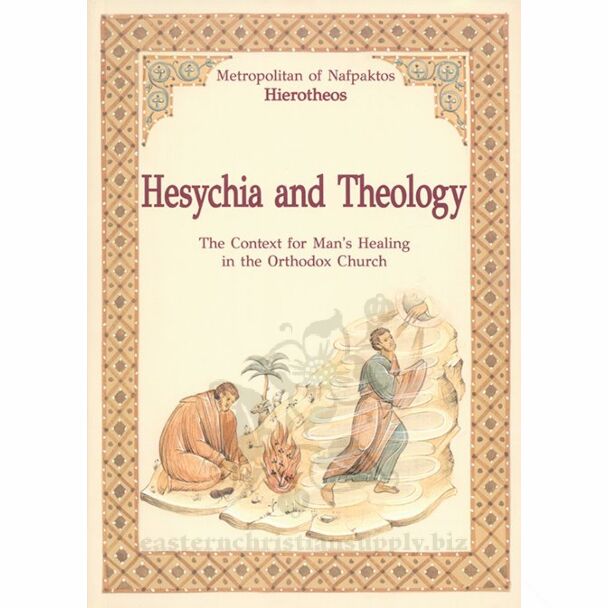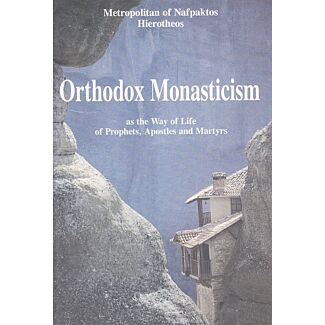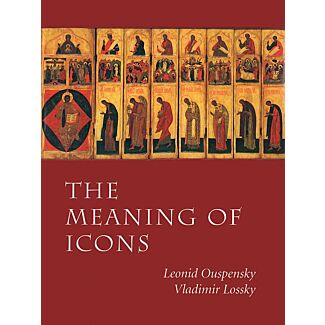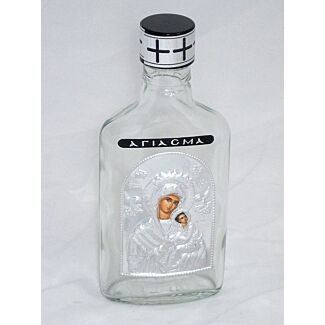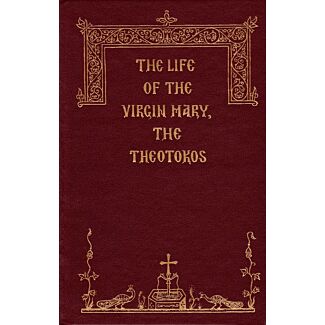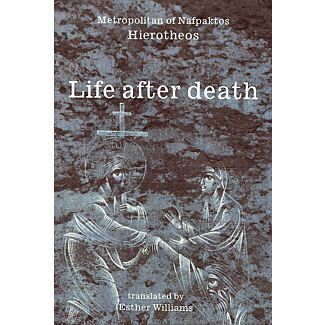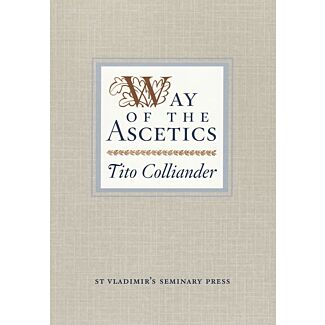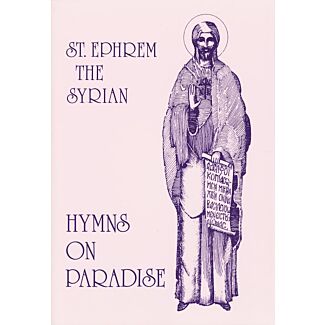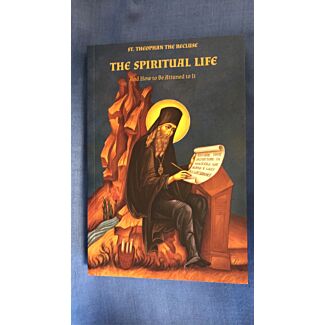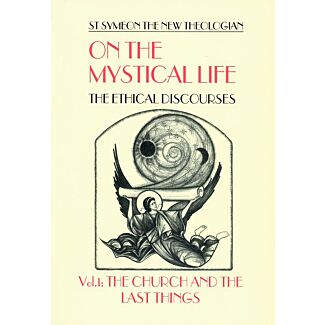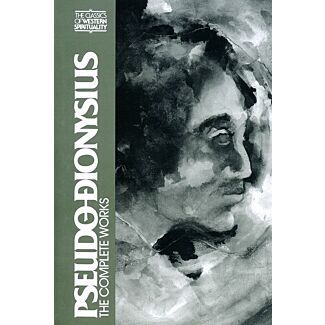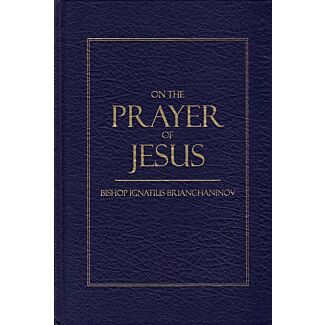Hesychia and Theology: The Context for Man’s Healing in the Orthodox Church
Metropolitan of Nafpaktos Hierotheos
Publication Data: Levadia, Greece: Birth of the Theotokos Monastery, 2007
Format: softcover
Number of Pages: 463
Dimensions (l × w × h): 22.0 cm × 15.7 cm × 3.2 cm
ISBN: 978‒960‒7070‒60‒9
Metropolitan of Nafpaktos Hierotheos
“Hesychia and theology, as they are expressed in the works of the holy Fathers, are two important spiritual realities in the life and teaching of our Church. Most significant of all, however, is the fact that these two focal points are so closely interlinked. Theology is speaking about God. But talking about God without error is not something intellectual: it comes from the revelation of God to the pure human heart. God is revealed to man, and he in turn speaks unerringly about God. Hesychia, in the full Orthodox sense of the term, is an indispensable element of divine revelation and of human expression of Orthodox theology. It entails a life of constant watchfulness (nepsis*), which prepares a person to become a bearer of divine revelation. On the one hand, hesychia precedes the vision of the glory of God (theoria) and theology; on the other hand, it follows on from revelational theology.”
—“Preface to the Greek Edition”
CONTENTS
Preface to the English Edition
Preface to the Greek Edition
Instead of an Introduction
1
Sanctity in the Orthodox Tradition
1. Saints by Participation in God
2. Sanctification of Soul and Body
3. Tokens of Sainthood
4. Honouring the Saints
5. Categories of Saints
6. The Gift of Discernment
2
The Covenant of God
1. The Meaning of ‘Covenant’
2. The Old Covenant
a) Moses the God-Seer
b) Moses’ Ascents and Descents of Mount Sinai
c) Key Points of this Revelation
3. The New Covenant
a) Christ and the New Covenant
b) Commandments – Blood – Supper
4. Personal Covenant
a) The Advent of Divine Grace
b) Spiritual Co-operation
c) The Divine Eucharist
5. Conclusion
3
The Spiritual Law
1. Different Levels of the Law
2. The Spiritual Law according to St Mark the Ascetic
a) What is the Spiritual Law?
b) The Spiritual Law in Man’s Striving for Purity
c) The Spiritual Law on the Activity of the Passions and their Healing
d) The Spiritual Law in Temptations, Afflictions and Trials
e) The Spiritual Law in Relation to Spiritual Gifts
3. Conclusions
4
The Neptic Theology of the Orthodox Church as a Therapeutic Method
1. Orthodox Watchfulness (Nepsis) and Hesychia
2. The Context of Orthodox Theology
3. Significant Texts from the Holy Fathers of the Church
4. A Contemporary Man Completely Cured
5. Orthodox Theology in Relation to Frankl’s Existential Psychology and Contemporary Neurology and Psychiatry
5
The Sacrament of Repentance as the Church’s Therapeutic Praxis
1. Man’s State before the Fall
2. The Aim and Work of Repentance
3. The Church’s Method of Healing
4. Some Examples
6
The Person of the Spiritual Father and the Gift of Discernment
1. The Person of the Spiritual Father
2. The Priest as Father and Mother
3. Man’s Healing
4. The Pastoral Theology of the Sacred Canons of the Church
a) Ecclesiological Interpretation of the Sacred Canons
b) The Spiritual Father’s Gift of Discernment
c) Applying the Canons Strictly or with Economy
d) The Person who Implements the Canons
5. Conclusion
7
Holy Scripture and Worship
1. The Unincarnate and Incarnate Word
2. Created and Uncreated Worship
3. Types, Signs and Symbols
4. Communion of Persons or Communion of Nature(s)?
5. The Church Militant and the Church Triumphant
6. The Spoken Word and Sighs too Deep for Words
8
The Readings for the Feasts of the Lord and the Mother of God
1. Holy Scripture and Worship
a) Holy Scripture and the Experience of Revelation
b) Prophets and Apostles
c) The Unincarnate and the Incarnate Word
d) Unutterable Words and Created Words and Concepts
e) The Created and Uncreated Law
f) The Created and Uncreated Temple
2. Readings for the Feasts of the Lord and the Mother of God
a) Readings for Feasts of the Lord
b) Readings for Feasts of the Mother of God
3. Conclusion
9
From the Morning Watch until the Night
1. The Meaning of the Verse from the Psalms
2. Elder Sophrony
3. Elder Sophrony’s ‘Prayer at Daybreak’
a) Personal Relationship with God
b) Profound Self-Accusation
c) Seeking a Blessing on the Whole Day
d) Healing of the Will
e) Eschatological Prayer
4. Living Examples
5. The Text of the Prayer at Daybreak
10
Spiritual Inspiration
1. What is Spiritual Inspiration?
2. The Characteristics of Spiritual Inspiration
3. The Struggle to Experience and Preserve Spiritual Inspiration
a) Continuous Awareness that God is Everywhere Present
b) Striving to Express Love towards Others
c) Unwavering Search for Spiritual Ascent
d) Overcoming Death
e) Dealing with Thoughts
f) Keeping Christ’s Commandments
4. Conclusion
11
The Path to Deification
1. The Life of St Mary of Egypt
2. Theological Lessons from the Life of St Mary of Egypt
a) The Gift of Baptism
b) The Grace of Repentance
c) The Experience of the Mystery of the Cross
d) Sharing in God’s Deifying Energy
e) The Suspension of Bodily Energies
f) The Action of Holy Communion
g) The Gift of a Blessed End
h) The Blessed Figures of Abba Zosimas and St Sophronius
i) Overcoming the Division between the Sexes
j) The Co-existence of Sacramental and Spiritual Priesthood
12
Nous and Perception according to St Diadochos of Photiki
1. One Hundred Texts on Spiritual Knowledge
a) Introduction
b) Contents of the Book
c) The Preface: The Ten Definitions
2. The Nous and its Purification
a) Relationship and Antagonism between Soul and Body
b) Energy and Purification of the Nous
3. Perceptive Faculties of the Nous and Heart
a) The Senses of the Soul and the Body
b) Demonic Energy – the Bodily Senses Energy of Grace – the Soul’s Perceptions
c) Perceptive Faculties of the Nous, Heart and Soul
d) Conscious Perception and Assurance
e) Perception and Spiritual Knowledge
f) Perceiving God as Light
13
Ecumenism in Praxis: in Theology and Asceticism
1. The Basic Theories of Ecumenism
2. Ecumenism in Theology
a) Some Typical Examples
b) The Views of Professor John Karmiris
c) The Error of these Views
3. Ecumenism in Asceticism
a) Orthodox Asceticism
b) Neoplatonism and Orthodox Neptic Theology
c) The Teaching of St Maximos the Confessor on Practical, Natural and Theological Philosophy
d) The Teaching of St Nikitas Stithatos on the Degrees of Purification, Illumination and Perfection
4. Conclusion
14
Orthodox and Secularised Theology
1. The Perfect Life
2. Truth and Falsehood
3. Moses the Great Theologian
a) Worldly Education and Philosophy
b) The Mystery of the Theophany in the Burning Bush
c) Prayer in Theoria and the Priesthood
d) The Entry of Moses into the Darkness
e) The Death of Moses
4. The Journey of the People of Israel
5. The Situation Today
6. Conclusion
15
Monasticism according to St Eustathios of Thessaloniki
1. The Noble Purpose of Monasticism
2. The Three Classes of Monks
3. The Life of Monks as Revealed in the Service of Tonsure
4. Fallen Monks
5. Abbots without Bishops
16
Hesychia and Theology
1. The Content of the Book on Elder Paisios
2. Empirical Ecclesiology
3. Seer, Saint, Martyr
4. The Authenticity of the Book
5. Memory of the Heart
17
Hesychastic Elements in the Divine Eucharist
1. The Divine Eucharist as a Journey
2. Specific Hesychastic and Neptic Elements
a) The Presence of Angels
b) The Divine Eucharist and Noetic Liturgy
c) Enlightenment and Understanding the Gospel Readings
d) Distinction between Catechumens, Those Preparing for Illumination and the Faithful
e) The Prayer of the Cherubic Hymn
f) Commending our Whole Life to God
g) Supplications for a Peaceful and Holy Life
h) Priesthood as Martyrdom
i) Communion of the Holy Gifts
3. Conclusion
Format: softcover
Number of Pages: 463
Dimensions (l × w × h): 22.0 cm × 15.7 cm × 3.2 cm
ISBN: 978‒960‒7070‒60‒9
Metropolitan of Nafpaktos Hierotheos
“Hesychia and theology, as they are expressed in the works of the holy Fathers, are two important spiritual realities in the life and teaching of our Church. Most significant of all, however, is the fact that these two focal points are so closely interlinked. Theology is speaking about God. But talking about God without error is not something intellectual: it comes from the revelation of God to the pure human heart. God is revealed to man, and he in turn speaks unerringly about God. Hesychia, in the full Orthodox sense of the term, is an indispensable element of divine revelation and of human expression of Orthodox theology. It entails a life of constant watchfulness (nepsis*), which prepares a person to become a bearer of divine revelation. On the one hand, hesychia precedes the vision of the glory of God (theoria) and theology; on the other hand, it follows on from revelational theology.”
—“Preface to the Greek Edition”
CONTENTS
Preface to the English Edition
Preface to the Greek Edition
Instead of an Introduction
1
Sanctity in the Orthodox Tradition
1. Saints by Participation in God
2. Sanctification of Soul and Body
3. Tokens of Sainthood
4. Honouring the Saints
5. Categories of Saints
6. The Gift of Discernment
2
The Covenant of God
1. The Meaning of ‘Covenant’
2. The Old Covenant
a) Moses the God-Seer
b) Moses’ Ascents and Descents of Mount Sinai
c) Key Points of this Revelation
3. The New Covenant
a) Christ and the New Covenant
b) Commandments – Blood – Supper
4. Personal Covenant
a) The Advent of Divine Grace
b) Spiritual Co-operation
c) The Divine Eucharist
5. Conclusion
3
The Spiritual Law
1. Different Levels of the Law
2. The Spiritual Law according to St Mark the Ascetic
a) What is the Spiritual Law?
b) The Spiritual Law in Man’s Striving for Purity
c) The Spiritual Law on the Activity of the Passions and their Healing
d) The Spiritual Law in Temptations, Afflictions and Trials
e) The Spiritual Law in Relation to Spiritual Gifts
3. Conclusions
4
The Neptic Theology of the Orthodox Church as a Therapeutic Method
1. Orthodox Watchfulness (Nepsis) and Hesychia
2. The Context of Orthodox Theology
3. Significant Texts from the Holy Fathers of the Church
4. A Contemporary Man Completely Cured
5. Orthodox Theology in Relation to Frankl’s Existential Psychology and Contemporary Neurology and Psychiatry
5
The Sacrament of Repentance as the Church’s Therapeutic Praxis
1. Man’s State before the Fall
2. The Aim and Work of Repentance
3. The Church’s Method of Healing
4. Some Examples
6
The Person of the Spiritual Father and the Gift of Discernment
1. The Person of the Spiritual Father
2. The Priest as Father and Mother
3. Man’s Healing
4. The Pastoral Theology of the Sacred Canons of the Church
a) Ecclesiological Interpretation of the Sacred Canons
b) The Spiritual Father’s Gift of Discernment
c) Applying the Canons Strictly or with Economy
d) The Person who Implements the Canons
5. Conclusion
7
Holy Scripture and Worship
1. The Unincarnate and Incarnate Word
2. Created and Uncreated Worship
3. Types, Signs and Symbols
4. Communion of Persons or Communion of Nature(s)?
5. The Church Militant and the Church Triumphant
6. The Spoken Word and Sighs too Deep for Words
8
The Readings for the Feasts of the Lord and the Mother of God
1. Holy Scripture and Worship
a) Holy Scripture and the Experience of Revelation
b) Prophets and Apostles
c) The Unincarnate and the Incarnate Word
d) Unutterable Words and Created Words and Concepts
e) The Created and Uncreated Law
f) The Created and Uncreated Temple
2. Readings for the Feasts of the Lord and the Mother of God
a) Readings for Feasts of the Lord
b) Readings for Feasts of the Mother of God
3. Conclusion
9
From the Morning Watch until the Night
1. The Meaning of the Verse from the Psalms
2. Elder Sophrony
3. Elder Sophrony’s ‘Prayer at Daybreak’
a) Personal Relationship with God
b) Profound Self-Accusation
c) Seeking a Blessing on the Whole Day
d) Healing of the Will
e) Eschatological Prayer
4. Living Examples
5. The Text of the Prayer at Daybreak
10
Spiritual Inspiration
1. What is Spiritual Inspiration?
2. The Characteristics of Spiritual Inspiration
3. The Struggle to Experience and Preserve Spiritual Inspiration
a) Continuous Awareness that God is Everywhere Present
b) Striving to Express Love towards Others
c) Unwavering Search for Spiritual Ascent
d) Overcoming Death
e) Dealing with Thoughts
f) Keeping Christ’s Commandments
4. Conclusion
11
The Path to Deification
1. The Life of St Mary of Egypt
2. Theological Lessons from the Life of St Mary of Egypt
a) The Gift of Baptism
b) The Grace of Repentance
c) The Experience of the Mystery of the Cross
d) Sharing in God’s Deifying Energy
e) The Suspension of Bodily Energies
f) The Action of Holy Communion
g) The Gift of a Blessed End
h) The Blessed Figures of Abba Zosimas and St Sophronius
i) Overcoming the Division between the Sexes
j) The Co-existence of Sacramental and Spiritual Priesthood
12
Nous and Perception according to St Diadochos of Photiki
1. One Hundred Texts on Spiritual Knowledge
a) Introduction
b) Contents of the Book
c) The Preface: The Ten Definitions
2. The Nous and its Purification
a) Relationship and Antagonism between Soul and Body
b) Energy and Purification of the Nous
3. Perceptive Faculties of the Nous and Heart
a) The Senses of the Soul and the Body
b) Demonic Energy – the Bodily Senses Energy of Grace – the Soul’s Perceptions
c) Perceptive Faculties of the Nous, Heart and Soul
d) Conscious Perception and Assurance
e) Perception and Spiritual Knowledge
f) Perceiving God as Light
13
Ecumenism in Praxis: in Theology and Asceticism
1. The Basic Theories of Ecumenism
2. Ecumenism in Theology
a) Some Typical Examples
b) The Views of Professor John Karmiris
c) The Error of these Views
3. Ecumenism in Asceticism
a) Orthodox Asceticism
b) Neoplatonism and Orthodox Neptic Theology
c) The Teaching of St Maximos the Confessor on Practical, Natural and Theological Philosophy
d) The Teaching of St Nikitas Stithatos on the Degrees of Purification, Illumination and Perfection
4. Conclusion
14
Orthodox and Secularised Theology
1. The Perfect Life
2. Truth and Falsehood
3. Moses the Great Theologian
a) Worldly Education and Philosophy
b) The Mystery of the Theophany in the Burning Bush
c) Prayer in Theoria and the Priesthood
d) The Entry of Moses into the Darkness
e) The Death of Moses
4. The Journey of the People of Israel
5. The Situation Today
6. Conclusion
15
Monasticism according to St Eustathios of Thessaloniki
1. The Noble Purpose of Monasticism
2. The Three Classes of Monks
3. The Life of Monks as Revealed in the Service of Tonsure
4. Fallen Monks
5. Abbots without Bishops
16
Hesychia and Theology
1. The Content of the Book on Elder Paisios
2. Empirical Ecclesiology
3. Seer, Saint, Martyr
4. The Authenticity of the Book
5. Memory of the Heart
17
Hesychastic Elements in the Divine Eucharist
1. The Divine Eucharist as a Journey
2. Specific Hesychastic and Neptic Elements
a) The Presence of Angels
b) The Divine Eucharist and Noetic Liturgy
c) Enlightenment and Understanding the Gospel Readings
d) Distinction between Catechumens, Those Preparing for Illumination and the Faithful
e) The Prayer of the Cherubic Hymn
f) Commending our Whole Life to God
g) Supplications for a Peaceful and Holy Life
h) Priesthood as Martyrdom
i) Communion of the Holy Gifts
3. Conclusion
Write Your Own Review
Frequently Bought Together
-
This Item:
$48.95
-
Orthodox Monasticism as the Way of Life of Prophets, Apostles and Martyrs
$50.95
-
The Meaning of Icons (soft cover)
$59.95
-
8-fluid ounce holy water bottle
$11.50
-
The Life of the Virgin Mary, the Theotokos: viewed and treated within the framework of Sacred Scriptures, Holy Tradition, Patristics and other ancient writings, together with the Liturgical and Iconographic Traditions of the Holy Orthodox Church
$52.95
-
Life after Death
$40.95
Total price
Customers Who Bought This Item Also Bought



